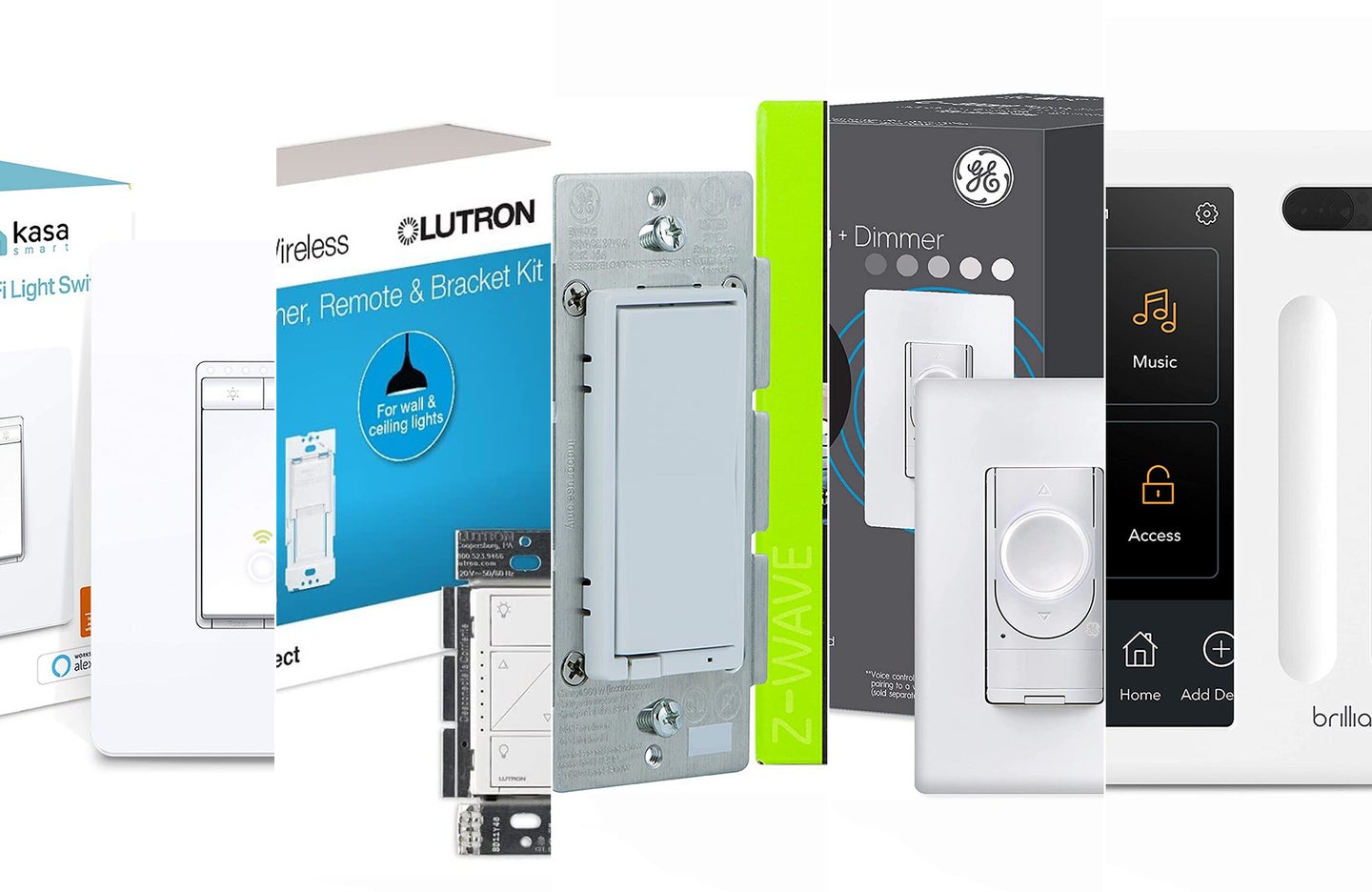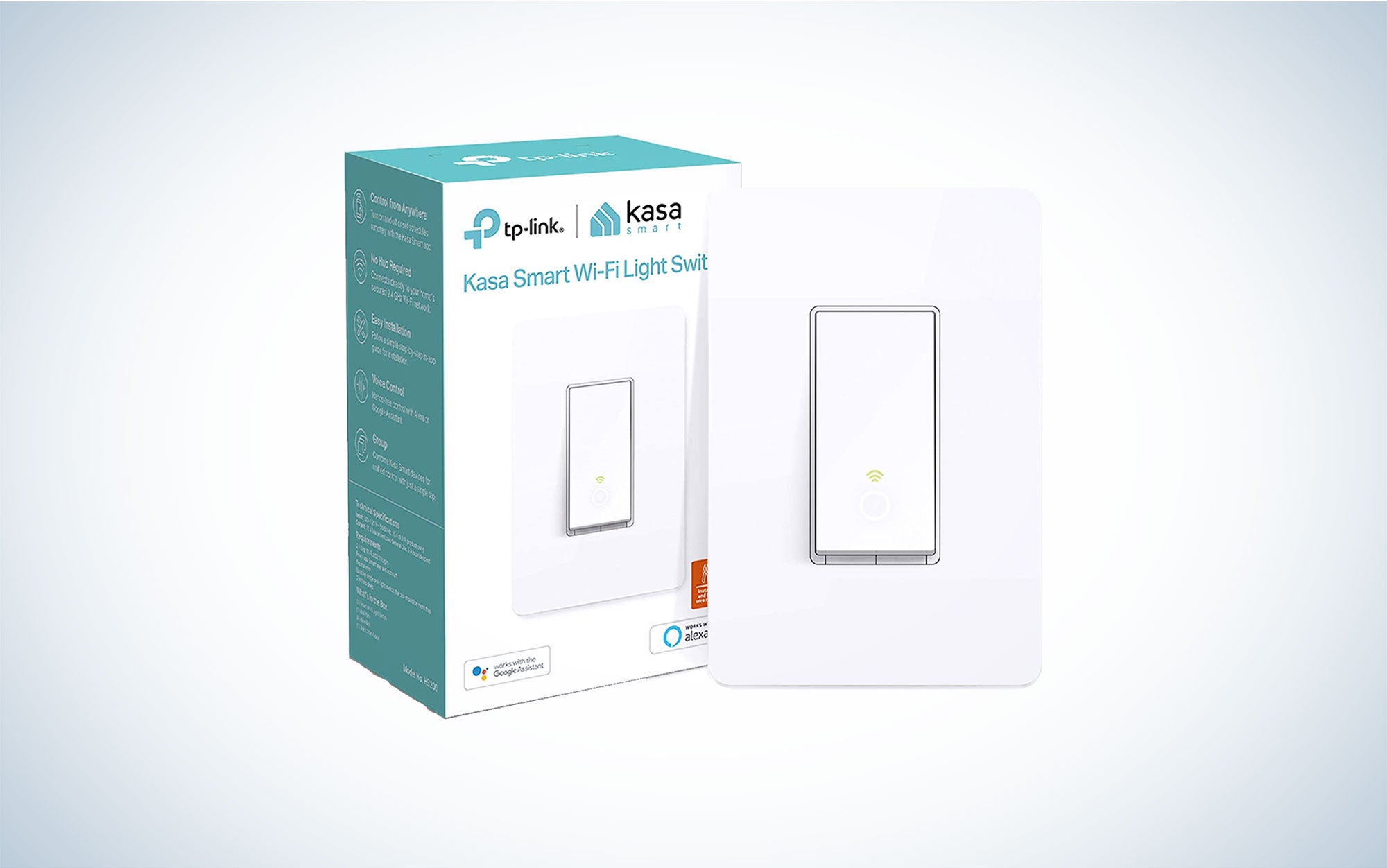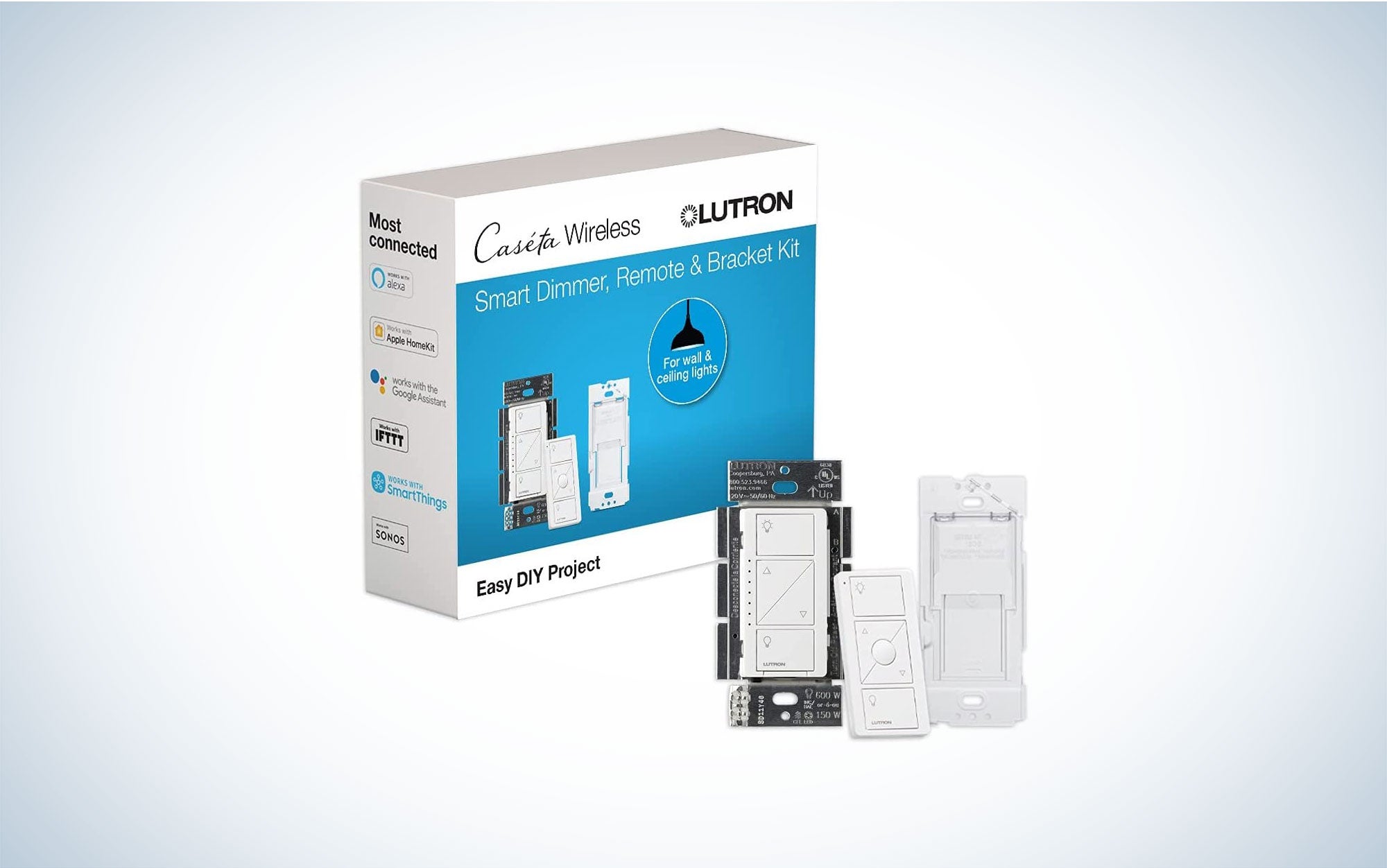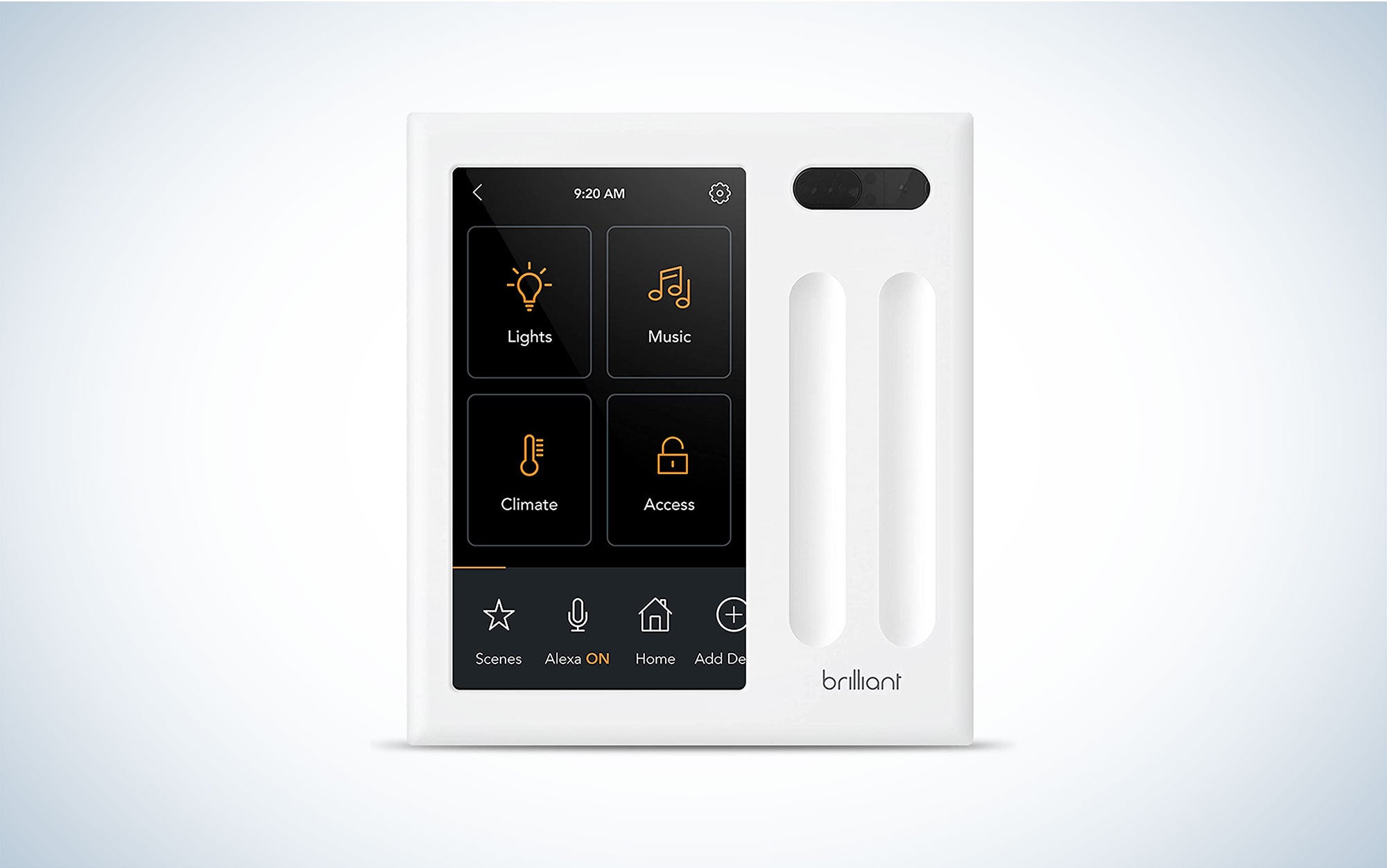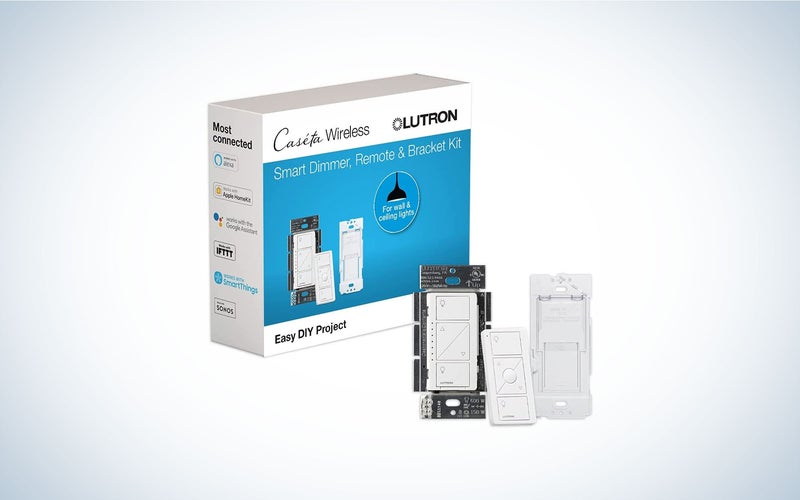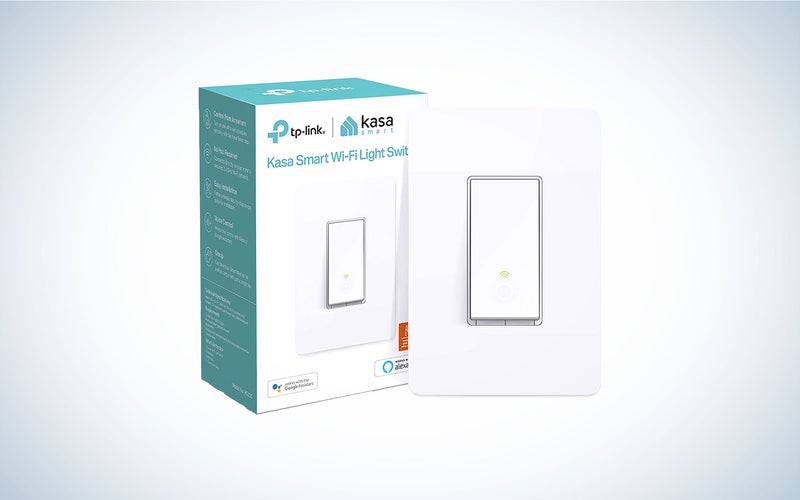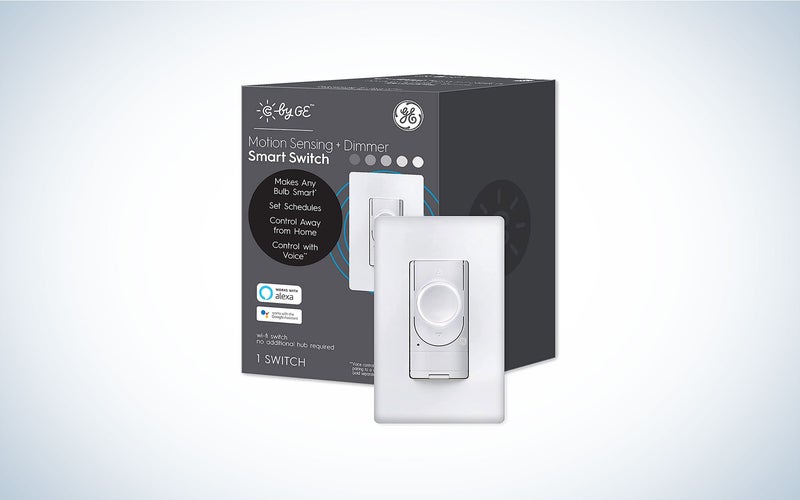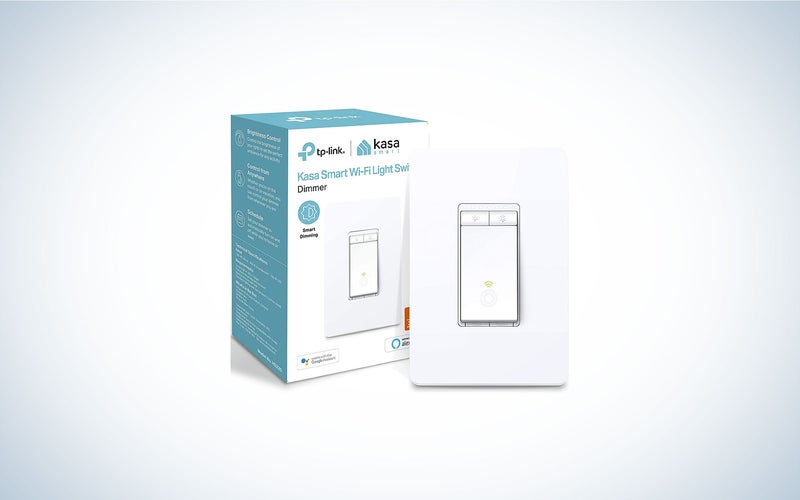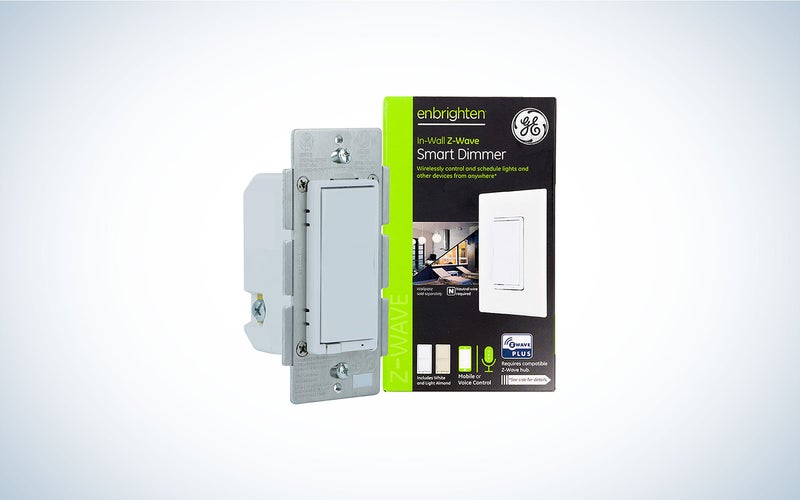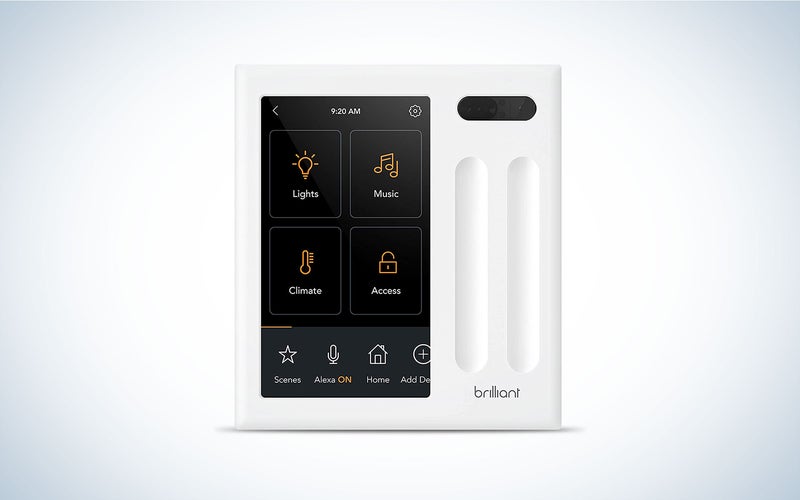We may earn revenue from the products available on this page and participate in affiliate programs. Learn more ›
Smart light switches, which add online-enabled features to your home lighting, might not seem like an upgrade to what you probably already have in your home. While they often look nearly identical, they allow you to turn your home lights wirelessly, as well as a variety of other useful and fun features. For example, a switch with motion detection can automatically turn lights on and off, saving you some money and helping the environment.
While it is a far cry from flying cars and hoverboards, smart light switches are a subtly helpful smart home upgrade, and they’ve evolved quite a bit over the past few years. While there are dozens of options to choose from, only the best smart light switches find the right balance between cost and utility.
- Best overall: Lutron Caseta Smart Home Dimmer Switch and Pico Remote Kit
- Best budget: Kasa Smart Light Switch
- Best with motion-detection: GE Cync Smart Dimmer + Motion Sensor
- Best dimmer: Kasa Smart Dimmer Switch (HS220)
- Best 3-way dimmer: GE Enbrighten
- Best with a display: Brilliant Smart Home Control
How we selected the best smart light switches
I’ve reviewed tech and gadgets, including smart home devices, for over eight years now at publications like How-To-Geek and Digital Trends. In my experience, selecting any sort of product for a roundup demands you balance cost, features, build quality, and ease of use. Smart light switches have advanced quite rapidly in the past few years, so cost, upgrade-worthy features, and compatibility with your chosen smart home ecosystem often play an outsized role, regardless of your specific needs. As such, we’ve focused on smart light switches that connect via Wi-Fi and support the most useful ecosystems, including Amazon Alexa and Google Assistant.
Things to consider before buying a smart light switch
For the most part, the standard for smart light switch build quality has reached a point where you can generally trust that any modern model from a major brand should work reliably. As such, the key factor you want to keep in mind is whether a smart light switch will integrate into your current smart home ecosystem and the actual wiring of your home. (If you’re new to smart home upgrades, picking you may want to consider what other upgrades you may want to make in the near future.)
Installation
Many smart light switches will require a neutral wire, which works with the ground wire to essentially complete the circuit of your home’s electrical wiring so it can draw power even when it isn’t in use. While it’s common in homes built within the last 20 years or so, many houses do not have a neutral wire. If you don’t have a neutral wire running through your home, you will need to avoid models that require one.
The physical installation process itself is usually similar to wiring an analogue light switch. Essentially that means removing the faceplate, removing the switch assembly, unscrewing the wires, and re-screwing them back into the smart light switch according to the manual, replacing the new smart light switch assembly into the wall, and finally putting the faceplate back on. It should be a very easy installation for any electrician, contractor, or someone with experience working with electrical wiring.
That said, we strongly recommend that you hire a professional electrician to install your smart switches if you aren’t familiar with the work. Working with electrical wires, especially live ones, can be fatal. Since you will want to hire someone to install the switches, we recommend planning, purchasing, and installing smart switches throughout your home in a single procedure.
Communication protocol
Most smart home devices can simply and easily connect to your 2.4GHz home Wi-Fi network. Wi-Fi is the easiest way to link up your smart devices, but it’s isn’t necessarily the best, especially with an upgrade like smart light switches, which adds many new wireless connections if you replace every analog light switch in your home.
When you lean into making your home a smart home, the airwaves start to get congested very quickly. While you can connect many devices directly to your Wi-Fi network, the sheer number of devices can slow down all of your devices, including your computers, phones, and devices. To mitigate this issue, companies have adopted a pair of internal communication protocols, Z-Wave and Zigbee, that connect all your low-energy devices through a single Wi-Fi-connected hub. Think of it as a secondary Wi-Fi setup just for your smart home devices.
While both services provide similar functionality, there are some fundamental differences. Here’s a broad, concise description of how they differ: Z-wave is a more stringent protocol that makes devices plug-and-play. Zigbee is open-source and more widely used, but might require a bit of work getting it to function correctly as you add more and more devices.
Using Z-Wave or Zigbee adds an extra device (and expense)—the smart home hub that connects all the devices. Also, once you choose one system or the other, you will want to make sure all other smart home upgrades are compatible with the protocol you’ve chosen.
Ecosystems
Smart home ecosystems act as the user interface for all smart devices in your home. Unlike communication protocols, which help the devices talk to each other, the ecosystem dictates how you talk to your devices.
Choosing a smart home ecosystem often has a lot to do with what kind of phone you use. If you’re an Apple user, you’ll likely want Apple HomeKit products, since you can easily interface with them through an app on your phone. Similarly, if you’re using Android and Google Assistant often, then Google Home and Google devices are likely the best bet for you.
That said, there are quite a few platform-agnostic ecosystems if you aren’t committed to embracing your phone’s built-in tools. For example, Samsung Smart Things is a very popular ecosystem and great if you already use a Samsung phone or device. Alternatively, Amazon’s Alexa Smart Home boasts one of the most extensive compatibility lists, allowing you to keep your device options open.
Thankfully, the majority of smart light switches tend to support Google Assistant and Amazon Alexa as a minimum. There are a few models with their own proprietary systems, but most connect to many ecosystems and can reach more with an extra piece of hardware called a bridge. Whichever ecosystem you choose, just make sure that the smart light switch supports it.
The best smart light switches: Reviews & Recommendations
In recent years, the smart home hardware industry has exploded. There are dozens of switches that work on several different ecosystems and communication protocols.
To be honest, it can get pretty overwhelming. Our picks for the best smart light switches cover all the basics; everything you’ll need to fully kit out your house with lights you can adjust and program with your phone. With one of our picks in hand, you can go back to building or renovating your dream home, rather than fretting over whether you made the right choice.
Best smart light switch overall: Lutron Caseta Smart Home Dimmer Switch and Pico Remote Kit
Lutron
Why it made the cut: The Lutron Caseta costs a little bit extra, but you get an excellent array of features.
Specs:
- Communication Protocol: Lutron Clear Connect
- Ecosystems: Apple HomeKit, Google Assistant, Amazon Alexa, Nest, SmartThings
- Neutral wire required: No
- Dimmer: Yes
- Supports three-way switches: Yes
Pros:
- Comes with a remote
- Good selection of features
- Wide ecosystem support
Cons:
- A bit expensive
- Requires Smart Bridge to connect to Wi-Fi
If you’re installing smart light switches for the first time, the Lutron Caseta kit comes with everything you need without having to worry about integrations and ecosystems. It’s easy to set up, especially since it doesn’t require a neutral wire. It comes with its own remote, so you don’t need a hub. Plus, it has some great features, like the included wall plate bracket and the ability to turn lights on and off randomly throughout the day to make it appear as if you’re at home.
There is a catch, of course. Lutron’s Caseta products require a Caseta Smart Bridge to pair with ecosystems other than Lutron’s. The Smart Bridge has its advantages, though. In addition to connecting with Apple HomeKit, Nest, and other ecosystems, it allows the dimmer to change the intensity of your lights based on season and time of day. With the Lutron app (iOS, Android), you can easily manage this sort of schedule on your own.
If you want full ecosystem integrations or just plan to expand to other smart light switch types, you can always go right for the Lutron Caseta bundle with the bridge.
Best budget smart light switch: Kasa Smart Light Switch
Kasa
Why it made the cut: The Kasa smart light switch is minimalist by definition. For those who don’t need any fancy features, its budget pricing makes it an excellent choice.
Specs:
- Communication Protocol: 2.4GHz Wi-Fi
- Ecosystems: Google Assistant, Amazon Alexa, Microsoft Cortana
- Neutral wire required: Yes
- Dimmer: No
- Supports three-way switches: No
Pros:
- No need for a hub
- Looks and feels like a normal light switch
- Good virtual assistant support
- Easy installation
Cons:
- Requires a neutral wire
- Doesn’t work with Siri or Apple Homekit
There aren’t many smart light switches that cost less than $20, especially among those made by well-known brands like TP-Link. The Kasa smart light switch is a rare option that is both affordable and useful enough to warrant an upgrade from analog switches.
Unlike other smart light switches, the Kasa doesn’t require a smart home hub. It connects via Wi-Fi, so it’s easy to set up. As we mentioned, this can be a double-edged sword if you install many switches and/or lack a newer wireless router: On the one hand, it’s cheap and easy to install. On the other hand, it adds a lot of congestion to your home Wi-Fi network. Even with Wi-Fi 6 and MU-MIMO support, having several light switches on your network can cause issues.
Despite this, the Kasa smart light switch has quite a few redeeming features. There’s support for all the main virtual assistants, except for Siri, so that you can control it by voice. There’s also scheduling for it to be on and off and a pretty smart ‘Away Mode,’ which randomly switches itself on and off to scare any potential burglars.
Best motion-detection smart light switch: GE Cync Smart Dimmer + Motion Sensor
GE
Why it made the cut: While a bit pricey, the GE Cync feels like a no-brainer if you’re looking for a smart dimmer thanks to its ambient light sensor and support for multiple popular ecosystems.
Specs:
- Communication Protocol: 2.4GHz Wi-Fi, Bluetooth
- Ecosystems: Amazon Alexa, Google Home
- Neutral wire required: No
- Dimmer: Yes
- Supports three-way switches: No
Pros:
- No need for a hub
- Can detect motion and ambient light
- Easy installation
Cons:
- App is less than ideal to use
- Occasional sensor issues when dealing with LED lights
The most advanced version of the GE Cync smart switch line—formerly known as “C by GE”—adds a very useful feature to the smart light switch equation: a motion sensor to detect when people enter and exit a room so your light always turns on and off exactly when you need them. In addition to being very convenient, the sensor does wonders for your home’s power efficiency, which cuts down on energy costs and reduces its carbon footprint.
Like our budget pick, the Kasa, the CYNC connects exclusively via 2.4Ghz Wi-Fi, though it also uses Bluetooth to connect to your phone via the Cync app (iOS, Android). The app allows you to control the dimmer directly and set other features like timers and light grouping.
As a final note, there’s a cheaper version of the Cync that doesn’t need to be wired to your home’s power, instead of being powered by an internal battery, which GE claims should last for up to two years. That’s a solid option for a quick, electrician-free upgrade, which may make sense if you’re only installing the smart dimmer, rather than upgrading all the switches in your home.
Best smart dimmer: Kasa Smart Dimmer Switch (HS220)
Kasa
Why it made the cut: Kasa’s smart dimmer gets you more precise lighting control for the lowest possible price.
Specs:
- Communication Protocol: 2.4GHz Wi-Fi
- Ecosystems: Amazon Alexa, Google Assistant/Home, Microsoft Cortana
- Neutral wire required: Yes
- Dimmer: Yes
- Supports three-way switches: No
Pros
- No Hub required
- Simple to operate
- Great customization
- Minimalist aesthetic
Cons
- No Apple HomeKit support
- Large design might not fit everywhere
- The dims in steps, rather than a dial
If you’re looking to kit out your whole house with a smart dimmer switch, the Kasa Smart Dimmer Switch will save you a pretty penny. At less than $20 per switch, it’s cheaper than average, but still delivers a full range of basic smart features. Our favorite is the “Gentle Off” function, which slowly dims the lights when you turn them off. Of course, there’s also the typical scheduling, scenes, and remote control from your phone and by voice.
Much like other devices that use 2.4Ghz Wi-Fi, it can connect with most virtual assistants and Google Home, but sadly does not play well with Apple HomeKit. That makes for an easy connection, although it does require a neutral wire, so it isn’t an easy install. In fact, the internal components of the switch are relatively large, so make sure you have enough clearance for it and the cables inside the gang box, aplastic or metal housing that holds electrical components like light switches or outlets.
Another thing to consider is that it’s done through steps rather than being a dial-based dimmer, so you won’t get the same level of fine control that you would with an analog dimmer dial. This isn’t necessarily a dealbreaker for most people, but it isn’t something you’d anticipate looking at the box.
Best 3-way smart dimmer switch: GE Enbrighten
GE
Why it made the cut: The GE Enbrighten has a little bit of everything, including a hub extender.
Specs:
- Communication Protocol: Z-Wave
- Ecosystems: Amazon Alexa, Google Assistant
- Neutral wire required: Yes
- Dimmer: Yes
- Supports three-way switches: Yes
Pros:
- Has both dimmer and 3-way switch support
- Straight-forward installation
- Supports a wide range of hubs
Cons:
- Requires a hub
- Requires neutral wire
The GE Enbrighten is very useful if you already have a ton of smart home devices. It’s a core 3-way dimmer, as well as a Z-wave repeater that boosts your hub’s signal throughout your home.
While the majority of smart light switches on this list connect via Wi-Fi, the GE Enbrighten relies exclusively on Z-wave, so it will require a Z-wave hub to operate. Even with that limitation, it is still widely compatible with popular smart home ecosystems, including Smart Things and Wink, and voice commands through Alexa and Google Assistant.
Lastly, the compact, easy-fitting design comes in many colors, so you’ll have design options if you’re doing a home remodel.
Best smart light switch with a display: Brilliant Smart Home Control
Brilliant
Why it made the cut: For those who want a premium product and experience, you aren’t going to do much better than the Brilliant Smart Home Control.
Specs:
- Communication Protocol: 2.4 GHz Wi-Fi
- Ecosystems: Amazon Alexa, Google Assistant, Apple HomeKit, Ring, Sonos, Philips Hue, Ecobee, Honeywell Lyric
- Neutral wire required: Neutral and ground wires required
- Dimmer: Yes
- Supports three-way switches: Yes
Pros:
- Touchscreen control
- Can control several different devices from one spot
- Very aesthetically pleasing
- Built-in motion sensor
Cons:
- Very expensive
The Brilliant Smart Home Control goes above and beyond what we generally expect from a smart light switch, but it is excellent if you want the best of the best. The multi-switch dimmer features a 5-inch LCD touchscreen display, which allows you to control its many features and programmed routines, including those that include other connected smart devices on the same network. If you have multiple Brilliant switches, they can also connect and operate as an in-home intercom system. Even with one switch, the intercom is Alexa-enabled, allowing you to use voice commands.
Of course, between the display and the intercom hardware, Brilliant switches are a luxury option. Coming in at just under $450 for the two-switch model we recommend, and $400 for the less functional one-switch version.
FAQs
Q: Is there a 4-way smart light switch?
Yes, there are 4-way smart light switches that can control light from four different sources. Usually, the switch itself has four different positions that you can pick from, as well as being able to control it remotely from your phone.
Q: Do smart light switches need a hub?
Not necessarily. Some smart light switches need a hub or a bridge to communicate over Wi-Fi if they rely exclusively on Z-wave and/or Zigbee communication protocols, but many of them can connect directly to your Wi-Fi network out of the box. That said, putting many smart home devices on your network will likely impact your Wi-Fi speeds on other devices.
Q: Do smart light switches use electricity when off?
Yes, smart light switches draw electricity, even when the lights are off, so they can communicate with a hub, your Wi-Fi network, and you. It’s a very small amount of power, though: Usually around 2 watts when connecting over Wi-Fi and 0.5 watts when using Zigbee or Z-wave. In some cases, smart light switches feature an internal battery instead of drawing power from your home.
Q: Are smart light switches secure?
Smart light switches are generally secure if you buy from a reputable manufacturer, so long as your home network is secure. It doesn’t matter how secure the smart light switches are if the devices they connect to, like a router, are poorly secured.
Final thoughts on the best smart light switches
Like any home repair or upgrade, picking and installing smart light switches requires a lot of planning. It can be both nerve-wracking and a lot of fun.
In my experience, the biggest problems arise from the tug-of-war between wanting to spend as little as possible and getting the widest range of features. As you might have noticed based on our picks, we recommend taking a judicious, conservative approach. Focus on efficiency, rather than what you might want down the road: For example, you probably don’t need a dimmer switch in a guest bathroom or a closet. In those cases, a simple on/off switch will do.
They say, “measure twice, cut once.” Make sure everything works together before you go spending your money. But don’t forget: Smart light switches are cool tech, so take a little time and enjoy the process.
